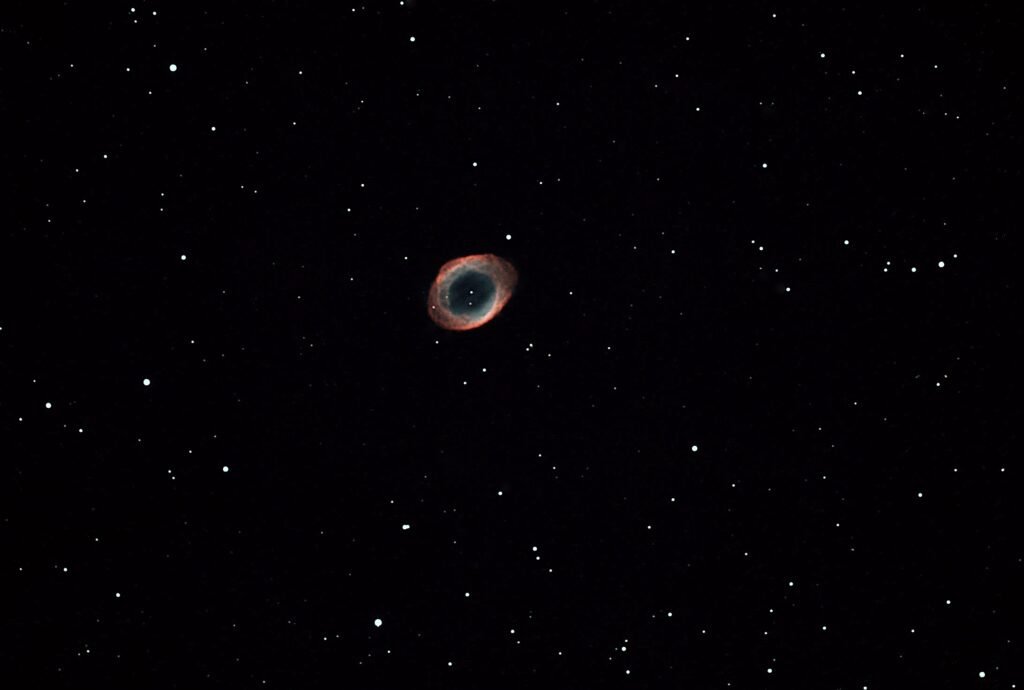One of the showpieces in the northern hemisphere summer sky is the famous "Ring Nebula" depicted in this image. Invisible to the naked eye, it emerges as a small, ghostly gray ring in small to medium aperture telescopes. No color is visible even through the largest telescopes. Color only emerges with time exposure images using film or a CCD camera. This image was a 70 minute exposure that clearly reveals not only color, but faint detail.
The Ring is some 2,500 light years away in the constellation Lyra, and is a planetary nebula. A planetary nebula is the residue of a star that exploded thousands of years ago. We are seeing the “shell” of the star that is blowing outward as a result of the intense radiation emitted by a small, white dwarf star in the center.
A planetary nebula results when stars with an initial mass of up to 8 times the mass of our Sun (about 95% of all stars) collapse at the end of their burning cycle when diminishing fuel is inadequate to produce fusion reactions sufficient to offset the inward and inexorable force of gravity. The inward collapse is abruptly halted by a force known as electron degeneracy (electrons resist occupying the same quantum state) if a star's final mass is below the "Chandrasekhar limit" of 1.44 solar masses. This produces a powerful "rebound" effect with energy pouring outward and blowing away the outer atmosphere of the star, creating a magnificent planetary nebula. The remaining star is now the size of the Earth, or a million times smaller than its original size, hot, and extremely dense, with a tablespoon weighing several tons. These stars no longer emit energy based on nuclear fusion. Planetary nebulae are amount the most beautiful objects in the universe.
For stars with initial masses greater than 8 or so solar masses the force of gravity overcomes the resistive force of electron degeneracy, producing either a neutron star or black hole.
As planetary nebulae continue to expand, they become larger and dimmer, meaning that they can be seen for only a relatively small window of time (up to 50,000 years). But, because planetary nebulae represent the final stage in the life of stars of up to 3 solar masses (the overwhelming majority of stars) they are common enough that there always are some visible.
The Ring is huge, spanning some 6,000,000,000,000 miles (one light year)! A Boeing 747 traveling 600 mph, 24 hours a day (5 million miles per year) would take 1,200,000 years to travel from one edge to the other. Its angular size in the sky is about 5% of the diameter of a full Moon. It is remarkable to think of a star's outer layers being dispersed over an area so large. The colors are caused by the emission of photons as hydrogen electrons that were boosted into the fourth energy orbit (n4) by the intense radiation of the central white dwarf star immediately release that energy as they cascade down to the second energy level (n2). The photons released by electrons making this transition have a wavelength that the human eye sees as blue-green light. The red color is caused by photons emitted by excited electrons descending from the third energy level (n3) to n2. The wavelengths of these photons are seen as red by the human eye.
The hot "white dwarf" star in the center of the nebula is relatively faint (magnitude 14.7) and was not detected until 1800. The star has collapsed several million times to the size of the Earth, but is very dense (a tablespoon of the star would weigh 10 tons) and luminous.
The "Ring Nebular" (M57) in Lyra
Date Taken:August 17, 2006
Location Taken: Conditions of Location:FWHM 2.5
Equipment Used:14.5" Ritchey-Chretien, SBIG ST-10XME CCD camera, Astrodon RGB filters, telescope command center, precision instrument rotator.
Processing Used:9 x 200 seconds luminance, and 9x90 seconds RGB, guided, processed in Maxim DL and Photoshop (total exposure 70 minutes)
Distance from Location:2,300 light years (the "light" you are seeing in this image left the nebula at the time of Alexander the Great)
Constellation:Lyra (the "lyre")
Other Link:
